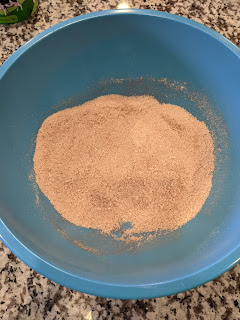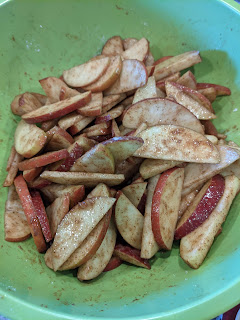Maker Basics - Basic Stitches, B*tches
Materials:
Yarn
Whatever size hook that is recommended by the yarn
Scissors
Patience
Whatever size hook that is recommended by the yarn
Scissors
Patience
The Wordy Bit
Okay, so you've read over my broad-strokes on yarn. You went to the yarn store (online, hopefully) and found the yarn you want to create with. The label said you need a certain sized hook, so you got that, too....or you dove head first in and bought a bundle of hooks and notions. Either way, you've got yarn and hook in hand and you're ready to go! Right...?
Well, if you're not, then this post may not be as informative as you were expecting. Maybe check back next week when I'm doling out my secrets on the perfect chicken nugget. Still here? Grab that yarn and hook, honey, and let's learn some basic stitches!
The Slipknot
Great band, but we're not here for the music. The foundation of any crochet project starts with a basic slipknot. So, I've got this picture here, and I'm going to explain my process. It seems simple to me, and I hope that translates well to you.
This is how we're going to start. The trailing bit of yarn going down to the bottom of the picture is our tail (where the beginning of the yarn is) and the trailing bit going off to the left is the "working" yarn (that goes to the rest of the cake/skein/hank). Once you've got your yarn like this, you'll use super pinchy fingers to grab the working yarn and pull it through the loop. You'll then, slowly tighten the looped knot onto the crochet hook until it is just snug. Congratulations, you've started your first crochet project! Next up: the ol' yarn and chain...
Chain
Abbreviated "ch" in crochet patterns, this is the foundation row of most projects. There are techniques you can learn that don't use chains, like the foundation single crochet. These methods create a tighter start to a project, yes, but they're a bit of a bear to learn. So, I like to still teach the basic chain. Chaining is also soothing.
This image also shows how you can incorporate the chaining method into making your slipknot. Once you have the first loop anchored on your hook, all you'll do is grab the working yarn with the hook and pull it through the loop. What will happen is a chain will be created, and the yarn you grabbed will now be the loop on your hook. Just do that as many times as your pattern calls for...or for however wide you want a blanket or dishcloth.
Note: as a basic rule of thumb, your chain is as wide as you want your project to be plus however many "turning chains" needed. The turning chain enables you to turn your work and start a new row. 1 turning chain is ample for a project in single crochet. 2 turning chains is usually used for half-double crochet and double crochet projects. 3 turning chains are usually used for treble crochet. Typically, a pattern will explain that in the beginning.
Single Crochet
The oft first taught stitches is the single crochet (SC in patterns). This stitch is a short stitch that gives a dense, warm fabric feel with little holes. It is also very slow going when taking on a larger project. I love single crochet for amigurumi and dish cloths, but I do not love it for garments or blankets. It just takes too long!
Once you've got your chain the length you need, add 1 chain for a turning chain. lay your chain across your lap so that you'll be working back towards the beginning. Start your work in the second chain from your hook.
Step 1: insert your hook into the chain.
Step 2: grab your working yarn with the hook and pull it through the chain (this is typically called "drawing up a loop"). At this point, you'll have two loops on your hook.
Step 3: grab your working yarn again and pull it through both loops on your hook.
Step 4: pull gently to close the stitch.
Step 5 starts you over again!
You did it! Now, keep going! Keep practicing those single crochets down the length of your chain. When you get to the end, count. This makes sure you have the same number of single crochets that you have chains (not counting turning chains). If you chained 10 chains plus 1 turning chain, you should end your first row of single crochet with 10 single crochet stitches.
Once you have the right number of stitches, you'll again use your turning chain (just chain 1), flip your work over and continue! And you do that until the end of time....just kidding! Only until you run out of yarn.
I hope you enjoyed this installment of Maker Basics. In two weeks, we'll be back going over half-double crochet and double crochet.
Well, if you're not, then this post may not be as informative as you were expecting. Maybe check back next week when I'm doling out my secrets on the perfect chicken nugget. Still here? Grab that yarn and hook, honey, and let's learn some basic stitches!
The Slipknot
Great band, but we're not here for the music. The foundation of any crochet project starts with a basic slipknot. So, I've got this picture here, and I'm going to explain my process. It seems simple to me, and I hope that translates well to you.
This is how we're going to start. The trailing bit of yarn going down to the bottom of the picture is our tail (where the beginning of the yarn is) and the trailing bit going off to the left is the "working" yarn (that goes to the rest of the cake/skein/hank). Once you've got your yarn like this, you'll use super pinchy fingers to grab the working yarn and pull it through the loop. You'll then, slowly tighten the looped knot onto the crochet hook until it is just snug. Congratulations, you've started your first crochet project! Next up: the ol' yarn and chain...
Chain
Abbreviated "ch" in crochet patterns, this is the foundation row of most projects. There are techniques you can learn that don't use chains, like the foundation single crochet. These methods create a tighter start to a project, yes, but they're a bit of a bear to learn. So, I like to still teach the basic chain. Chaining is also soothing.
This image also shows how you can incorporate the chaining method into making your slipknot. Once you have the first loop anchored on your hook, all you'll do is grab the working yarn with the hook and pull it through the loop. What will happen is a chain will be created, and the yarn you grabbed will now be the loop on your hook. Just do that as many times as your pattern calls for...or for however wide you want a blanket or dishcloth.
Note: as a basic rule of thumb, your chain is as wide as you want your project to be plus however many "turning chains" needed. The turning chain enables you to turn your work and start a new row. 1 turning chain is ample for a project in single crochet. 2 turning chains is usually used for half-double crochet and double crochet projects. 3 turning chains are usually used for treble crochet. Typically, a pattern will explain that in the beginning.
Single Crochet
The oft first taught stitches is the single crochet (SC in patterns). This stitch is a short stitch that gives a dense, warm fabric feel with little holes. It is also very slow going when taking on a larger project. I love single crochet for amigurumi and dish cloths, but I do not love it for garments or blankets. It just takes too long!
Once you've got your chain the length you need, add 1 chain for a turning chain. lay your chain across your lap so that you'll be working back towards the beginning. Start your work in the second chain from your hook.
Step 1: insert your hook into the chain.
Step 2: grab your working yarn with the hook and pull it through the chain (this is typically called "drawing up a loop"). At this point, you'll have two loops on your hook.
Step 3: grab your working yarn again and pull it through both loops on your hook.
Step 4: pull gently to close the stitch.
Step 5 starts you over again!
You did it! Now, keep going! Keep practicing those single crochets down the length of your chain. When you get to the end, count. This makes sure you have the same number of single crochets that you have chains (not counting turning chains). If you chained 10 chains plus 1 turning chain, you should end your first row of single crochet with 10 single crochet stitches.
Once you have the right number of stitches, you'll again use your turning chain (just chain 1), flip your work over and continue! And you do that until the end of time....just kidding! Only until you run out of yarn.
I hope you enjoyed this installment of Maker Basics. In two weeks, we'll be back going over half-double crochet and double crochet.





Comments
Post a Comment